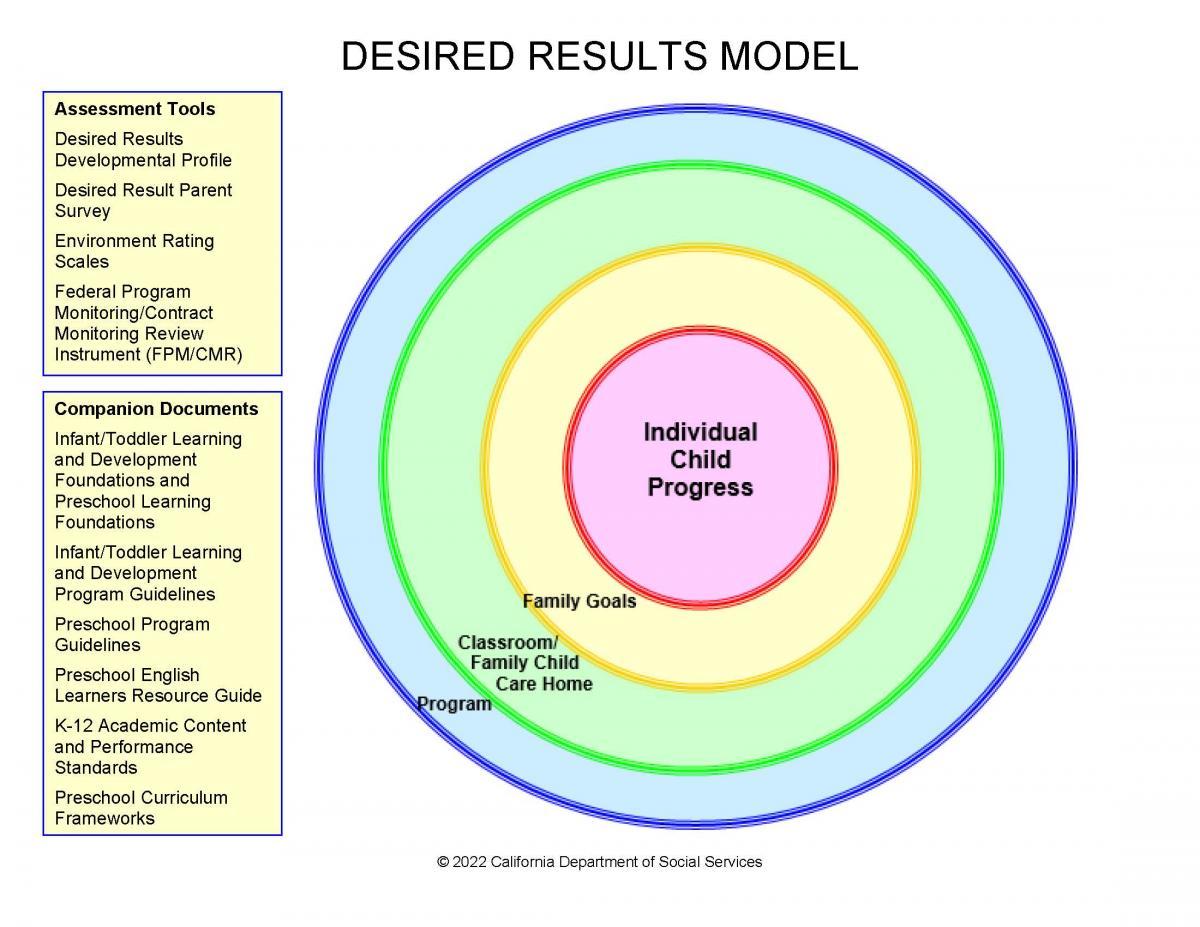Background of Desired Results for Children and Families
The Desired Results system, funded by the California Department of Social Services (CDSS) Child Care and Development Division (CCDD), is designed to improve the quality of programs and services provided to all children, birth through 12 years of age, who are enrolled in early care and education programs and before-and after-school programs, and their families. Desired Results (DR) are defined as conditions of well-being for children and families. Each DR defines an overall outcome. The DR system was developed based on six desired results – four for children and two for their families.
DR1: Children are personally and socially competent
DR2: Children are effective learners
DR3: Children show physical and motor competence
DR4: Children are safe and healthy
DR5: Families support their child’s learning and development
DR6: Families achieve their goals
The DR system implemented by the CDSS is a comprehensive approach that facilitates the achievement of the Desired Results identified for children and families. California is one of the few states in the nation that has developed a system designed specifically for measuring child progress toward desired outcomes. The system is aligned with the state's learning and development foundations for early care and education programs and the content standards for kindergarten.
The DR system consists of the following components:
1. Desired Results Developmental Profile© (DRDP©) assessment instruments
2. Desired Results Parent Survey
3. Environment Rating Scales (ERS)
4. Program Self-Evaluation
1. Desired Results Developmental Profile© (2015) A Developmental Continuum from Early Infancy up to Kindergarten Entry
The DRDP assessment instruments are designed for teachers to observe, document, and reflect on the learning, development, and progress of children, birth through 12 years of age, who are enrolled in early care and education programs and before-and after-school programs. The assessment results are intended to be used by the teacher to plan curriculum for individual children and groups of children and to guide continuous program improvement.
2. Desired Results Parent Survey
The Parent Survey is designed to assist programs in gathering information from families about (1) the family members' satisfaction with their child’s program and how it supports the child’s learning and development; and (2) family members' perceptions of their progress toward reaching the two Desired Results identified for families. Families in the program are asked to complete the Parent Survey once a year and return it to their classroom. Families complete this survey anonymously to ensure that their opinions and concerns are kept confidential.
3. Environment Rating Scales (ERS)
The ERS measure the program environment's quality (e.g., child-teacher interactions, children’s interactions, activities, use of language, health and safety practices, space, and materials). The ERS are required instruments for yearly program self-evaluation and are used for the reviews conducted by CDSS/CCDD program staff.
4. Program Self Evaluation
The Program Self Evaluation addresses: family and community involvement; governance and administration; funding; standards, assessment, and accountability; staffing and professional growth; opportunity and equal educational access; and approaches to teaching and learning. Program quality is assessed annually through the required self-evaluation and the reviews conducted by CDSS/CCDD program staff.
The Desired Results System model, a visual representation of the system, is a set of four concentric circles. The innermost circle represents the “heart” of the system, the individual child’s developmental progress. Progress is assessed using the Desired Results Developmental Profile© (DRDP©).
The next circle represents agencies’ support for families’ goals. Parent satisfaction is determined through the distribution and collection of Parent Surveys.
The third circle represents classroom or family child care home environments. The appropriateness of children’s environments is assessed by using the Environment Rating Scale (ERS) instrument.
The last circle represents the program or agency. Program quality is assessed using the Program Self Evaluation (PSE).
Supportive documents for implementing the model include Infant/Toddler and Preschool Learning Foundations, Infant/Toddler Learning and Development Program Guidelines, Preschool Program Guidelines, K-12 Academic Content and Performance Standards, California’s Preschool Framework, and the Preschool English Learners Resource Guide.
Download the Desired Results Model PDF | Modelo de resultados deseados PDF
